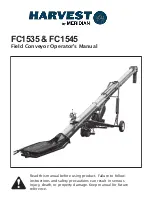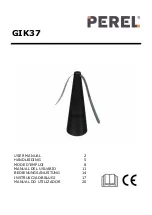
!
2B Transport Safety
_
•
Make sure the hitch on the towing vehicle is rated for the gross weight of the
towed machine.
•
Check with local authorities regarding transport of agricultural equipment on
public roads. Obey all applicable laws and regulations.
•
Always travel at a safe speed, never exceeding 20 mph (32 km/h). Reduce speed
on rough surfaces. Use caution when turning corners or meeting traffic.
•
Make sure the SMV (slow moving vehicle) emblem and all the lights and reflectors
that are required by local authorities are in place, are clean, and can be seen by
all over-taking and oncoming traffic. Always use hazard-warning flashers on
tractor/towing vehicle when transporting unless prohibited by law.
•
Do not allow riders on the machine, towing vehicle, tractor, or skid steer during
transport.
•
Stay away from overhead obstructions and power lines when operating and
transporting. Electrocution can occur without direct contact.
•
Fully lower conveyor before transporting, making sure the conveyor lifting slide is
firmly pressed against the transport stop. Keep light tension on the lifting cable.
•
When transporting, use a clevis-to-tongue connection. Never use a clevis-to-clevis
or tongue-to-tongue connection as this can lead to hitching failure.
•
Attach a conveyor to towing vehicle with a 3/4”pin and retainer. Always attach
safety chain(s).
•
The conveyor is not equipped with brakes. Make sure the tow vehicle has sufficient
braking capacity for the extra load. The conveyor may not exceed 1.5 times the
towing vehicle weight.
•
Check the tires for cracks and make sure they are inflated to 30 psi.
•
Do not transport conveyor on slopes greater than 20 degrees.
•
Only move your conveyor with a tractor/towing vehicle. Never move by hand.
!
!
7
Summary of Contents for FC1535
Page 8: ... Figure 2 Transport Safety Zones 8 ...
Page 39: ... 39 ...







































